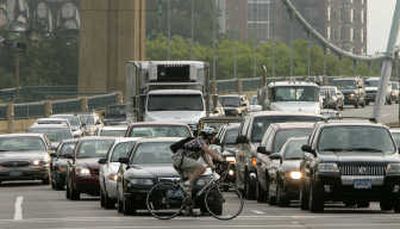Bridge collapse blame begins

MINNEAPOLIS – As questions mounted Monday about her political future and ability to lead the Minnesota Department of Transportation, Lt. Gov. Carol Molnau said she will not resign in the wake of the Interstate 35W bridge collapse.
“I have not offered my resignation nor do I think I’m going to do that,” said Molnau, who serves in a unique dual role as Gov. Tim Pawlenty’s second-in-command and state transportation commissioner.
Although last week’s transportation disaster occurred on her watch, Pawlenty defended her. “Yes. I think she’s doing a good job,” he said.
Molnau said she believes the people of Minnesota remain confident in MnDOT and its ability to safeguard the state’s bridges.
The rescue efforts, meanwhile, continued Monday as divers from the FBI arrived and the U.S. Navy brought an unmanned submarine to help find at least eight bodies believed missing in the Mississippi River.
The buzz over Molnau’s future began early Monday when State Senate Transportation Chairman Steve Murphy said in a Minnesota Public Radio interview that he lacked confidence in her leadership. Murphy said MnDOT “has not had an advocate at the top.”
Molnau is a longtime opponent of gas tax increases, whose proceeds would be dedicated to road and bridge construction and maintenance.
When asked whether he feels “confident that she can continue to do the job,” Murphy answered: “No.”
But Murphy shouldered some of the responsibility himself, pointing out that he was elected to the Legislature in 1992 along with Molnau and Pawlenty.
“For the last 15 years, we’ve failed to make headway on transportation issues with several people being culpable, myself included,” Murphy told the Star Tribune. “I just don’t think that right now, while we still have folks missing, we need to go through a finger-pointing exercise. I think that would be tacky.”
David Gaither, chief of staff to Pawlenty until late 2006, said he fears Molnau could become a distraction as the transportation funding debate heads for a possible special session where legislators could enact the first gas-tax increase since 1988.
Gaither said in an interview that Molnau stepping aside “might be the right and most noble thing to do. The public has to come away with trust the government has their safety first and foremost and when in doubt, you must err on the side of caution.”
Asked Monday whether he still had confidence in Molnau as transportation commissioner, Pawlenty said anyone who would jump to the conclusion that Molnau’s job is at risk “should be cautious.”
Molnau continued to focus Monday on the task ahead of ensuring Minnesota bridges are safe. Almost 400 bridges in the state are considered a high priority for inspection, she said, because they have similar designs to the I-35W bridge or carry a high volume of traffic.
The inspection work on those bridges has not begun and MnDOT spokesman Bob McFarlin did not have a timeline but said: “I hope that will be soon.”
McFarlin also continued to decline comment on whether construction workers on the bridge on the days prior to the collapse reported the bridge was wobbling.
MnDOT tried to end speculation that the additional weight and vehicle traffic that the bridge has experienced since it opened in 1967 might have contributed to the collapse. Assistant State Engineer Gary Peterson said enough safety designs were built in to the original bridge to accommodate today’s traffic flows and commercial vehicles.